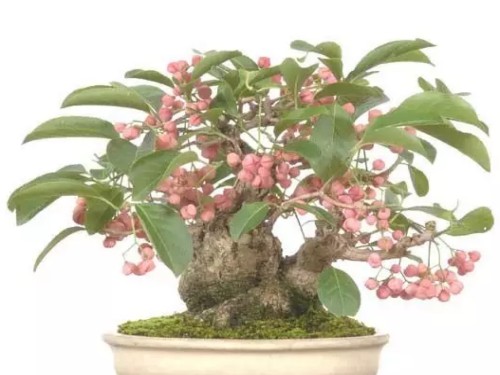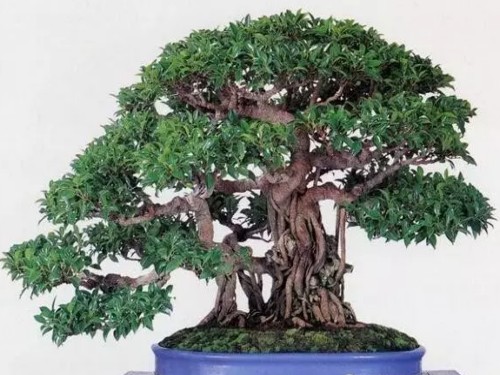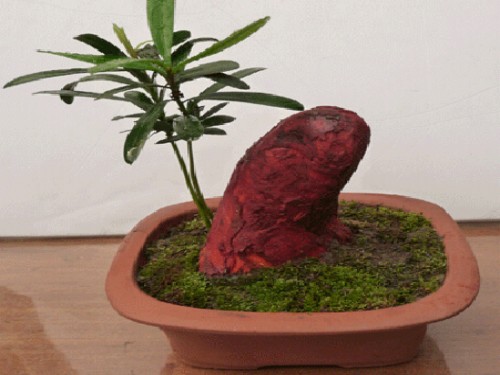How to raise bonsai well
Although bonsai is beautiful, it is difficult to maintain its form or even life without careful management and maintenance in the later stage. I have summed up the main reasons for the problems as follows:
1, watering dry humidity is not good, the most important point in maintenance is watering, general plants pay attention to dry and wet (no dry, no watering, watering thoroughly).
2, the sun is not enough, most bonsai are sunny, sufficient light can make the plants energetic.
3, hurt fat, many bonsai lovers have a misunderstanding, that is, want to eat into a fat person, the result is counterproductive, use fertilizer must remember to apply thin fertilizer frequently, use less chemical fertilizer.
Modern people's life is natural, fashionable and concise, and it is also very important to raise a plant, but how do families raise bonsai and how to raise bonsai well, do you know?

1. Suitable for lighting
Plants need photosynthesis, so sunlight is very necessary. In spring, summer and autumn, bonsai must be placed in a sunny place, and indoor bonsai must be exposed to the sun every three days, while southern indoor plants that are not defined by bonsai on the market are not needed. Indoor storage in winter must have sufficient diffuse light to maintain normal photosynthesis of the plant.
2. Pay attention to the temperature
Generally, the suitable ambient temperature of bonsai ranges from 20 ℃ to 35 ℃. It is important to grasp the time when bonsai enters the greenhouse. It is possible to enter the house in autumn about ten days after Frosts Descent. Entering the house after one or two slight frosts is conducive to germination and flowering in the coming year. Spring out of the room before and after Grain Rain, leaving the room early will cause spring freezing due to the obvious alternation of cold and warm.
3. Keep dry and humid
The most important thing to raise bonsai is to have a good grasp of dry and humidity, generally based on the principle of "no dry, no watering, no watering". It is about once every three to four days in spring and autumn, once a day in summer, and once a week or more in winter, depending on water evaporation. It is usually better to water at eight or nine o'clock in the morning. In the open bonsai rainy season, we should pay attention to clean up the stagnant water in time to prevent asphyxiation caused by lack of oxygen at the root of the plant.
4. Morphological control.
The bonsai bought home is already set. After a period of growth, the spread of the branches and leaves of the plant will lead to a change in the original shape. At this time, it is necessary to trim the branches and leaves to maintain the shape of the bonsai. The extent of pruning generally will not affect the survival of the plant, you can give full play to your understanding and creativity of bonsai modeling. When pruning, in order to avoid breaking leaves and bald branches, the cut should be placed on the stalk.
5. Cold prevention measures
For some cold-resistant plant pile scenery and small bonsai, to do a good job of cold prevention in winter, generally can be put indoors to survive the winter. Transfer outdoor maintenance in spring according to the situation. If you encounter a cold spell in spring, you should also move indoors in time.
6. Turn the basin and change the soil
Do not water before changing the basin, such as the rain is not clear for a long time, you can move the basin into the room, wait for the soil to dry, and remove the stump from the basin. First, remove the old soil with bamboo slices, and then cut off the old roots properly; tree species with well-developed roots and easy roots, such as pomegranate and rhododendron, can remove more soil and cut off more roots; if the roots are underdeveloped or new roots are not easy to occur, you can cut less or not. For those whose main roots such as Populus tomentosa and Luohansong grow less but have more lateral roots and are coiled around the basin, these lateral roots should be truncated, while those of Pinus elliottii, Pinus elliottii and Pinus elliottii who grow faster than lateral roots should be truncated.
When changing soil, first take broken tiles to pad the drainage hole, deep basin can add coarse soil particles, and then put in mature base fertilizer, and then add culture soil. In the case of shallow pots or miniature bonsai, plastic window screens or brown filaments are generally used to block the drainage holes to prevent the soil from leaking out; after the stump is planted, cover and shake the flowerpot, and then compact the soil. The basin soil should be at a certain distance from the basin mouth to avoid overflowing out of the basin when watering.
Of course, in addition to the above measures, there are the following precautions:
1. Avoid sudden shade
In general, in order to avoid high temperature injury, when the ambient temperature exceeds the maximum temperature tolerated by the pile, the bonsai should be moved to a relatively low temperature area with weak light (about 2 degrees) to facilitate the growth of the pile, but if it is suddenly moved into the indoor or low temperature area without light, within a few days, the leaves will fall off naturally, and the pile will quickly shrink and die.
2. avoid taking a bath in the afternoon
Do not spray water to the sunlit pile or water into the basin at noon in hot summer, this kind of "pet" way will make the bonsai temperature suddenly lower than the ambient temperature and hurt the pile.
3. Avoid drought
When I think of watering, I don't water it if I don't think of it. Sometimes I don't care for several days in a row. Once the leaves are found to be wilting, they quickly replenish the water, and the leaves return to normal. This is a reaction of the pile body to adapt to the environment, but for a long time, excessive transpiration will eventually make the pile body "sick" difficult to recover, dehydration and death.
4. Avoid water stains
When the ambient temperature exceeds 28 degrees, the bonsai should be protected by shade, otherwise, the amount of water obtained by the pile from the soil is much lower than that lost by transpiration, the leaf edge will be burned and scorched, and the pile will die from sunburn.
5. Avoid fertilizing
Due to the high temperature in midsummer and the rapid loss of water on the leaf surface, fertilization can make the concentration of pile cells less than that of the external environment, resulting in the reverse flow of water in plant cells and the death of piles due to fertilizer damage.
Time: 2019-05-31 Click:
- Prev

What if the leaves of banyan bonsai turn black?
Banyan tree can effectively remove formaldehyde, toluene, xylene, benzene, nitrogen oxides and ozone in volatile organic compounds. The ability of absorbing dust is strong, which can increase the temperature of indoor air very well. This species has a large crown and dense branches and leaves. Young trees are often potted indoors for ornamental use. Old stakes are used for bonsai. Leaves and air roots can be used as medicine.
- Next

How to raise sandalwood bonsai
We see all kinds of bonsai in many offices or balconies. Bonsai is a work of art that uses plants and rocks as basic materials to express the natural landscape in the basin. And I like sandalwood, when it comes to sandalwood, I believe many people know that it is also called white sandalwood, it belongs to the sandalwood family evergreen trees. At the beginning of blooming
Related
- Fuxing push coffee new agricultural production and marketing class: lack of small-scale processing plants
- Jujube rice field leisure farm deep ploughing Yilan for five years to create a space for organic food and play
- Nongyu Farm-A trial of organic papaya for brave women with advanced technology
- Four points for attention in the prevention and control of diseases and insect pests of edible fungi
- How to add nutrient solution to Edible Fungi
- Is there any good way to control edible fungus mites?
- Open Inoculation Technology of Edible Fungi
- Is there any clever way to use fertilizer for edible fungus in winter?
- What agents are used to kill the pathogens of edible fungi in the mushroom shed?
- Rapid drying of Edible Fungi

